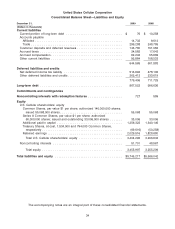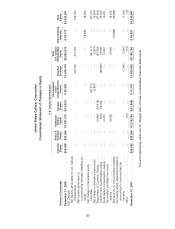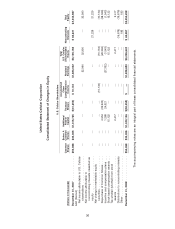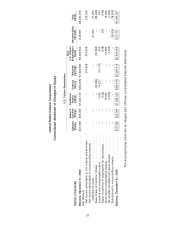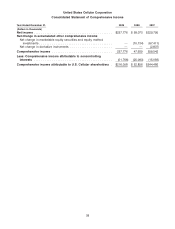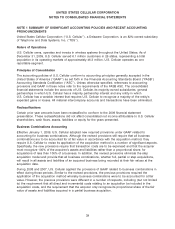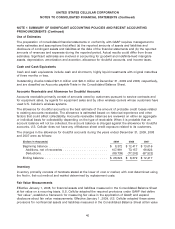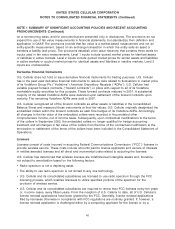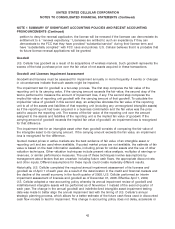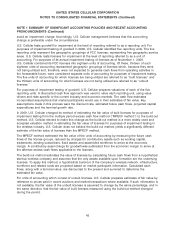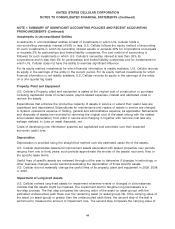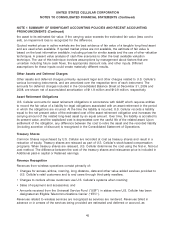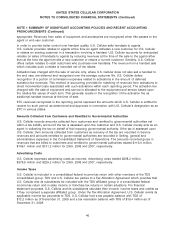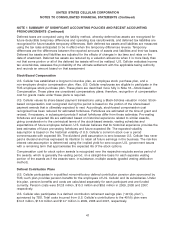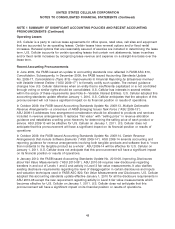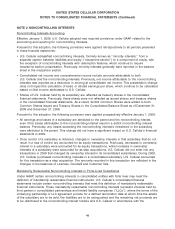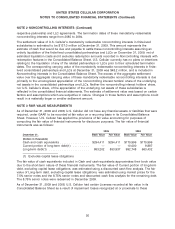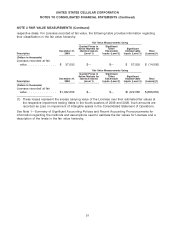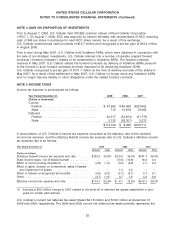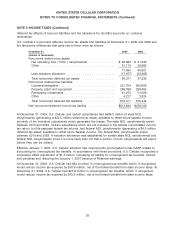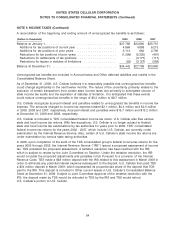US Cellular 2009 Annual Report Download - page 52
Download and view the complete annual report
Please find page 52 of the 2009 US Cellular annual report below. You can navigate through the pages in the report by either clicking on the pages listed below, or by using the keyword search tool below to find specific information within the annual report.UNITED STATES CELLULAR CORPORATION
NOTES TO CONSOLIDATED FINANCIAL STATEMENTS (Continued)
NOTE 1 SUMMARY OF SIGNIFICANT ACCOUNTING POLICIES AND RECENT ACCOUNTING
PRONOUNCEMENTS (Continued)
Investments in Unconsolidated Entities
Investments in unconsolidated entities consist of investments in which U.S. Cellular holds a
non-controlling ownership interest of 50% or less. U.S. Cellular follows the equity method of accounting
for such investments in which its ownership interest equals or exceeds 20% for corporations and equals
or exceeds 3% for partnerships and limited liability companies. The cost method of accounting is
followed for such investments in which U.S. Cellular’s ownership interest is less than 20% for
corporations and is less than 3% for partnerships and limited liability companies and for investments for
which U.S. Cellular does not have the ability to exercise significant influence.
For its equity method investments for which financial information is readily available, U.S. Cellular records
its equity in the earnings of the entity in the current period. For its equity method investments for which
financial information is not readily available, U.S. Cellular records its equity in the earnings of the entity
on a one quarter lag basis.
Property, Plant and Equipment
U.S. Cellular’s Property, plant and equipment is stated at the original cost of construction or purchase
including capitalized costs of certain taxes, payroll-related expenses, interest and estimated costs to
remove the assets.
Expenditures that enhance the productive capacity of assets in service or extend their useful lives are
capitalized and depreciated. Expenditures for maintenance and repairs of assets in service are charged
to System operations expense or Selling, general and administrative expense, as applicable. Retirements
and disposals of assets are recorded by removing the original cost of the asset (along with the related
accumulated depreciation) from plant in service and charging it, together with removal cost less any
salvage realized, to Loss on asset disposals, net.
Costs of developing new information systems are capitalized and amortized over their expected
economic useful lives.
Depreciation
Depreciation is provided using the straight-line method over the estimated useful life of the assets.
U.S. Cellular depreciates leasehold improvement assets associated with leased properties over periods
ranging from one to thirty years; such periods approximate the shorter of the assets’ economic lives or
the specific lease terms.
Useful lives of specific assets are reviewed throughout the year to determine if changes in technology or
other business changes would warrant accelerating the depreciation of those specific assets.
U.S. Cellular did not materially change the useful lives of its property, plant and equipment in 2009, 2008
or 2007.
Impairment of Long-lived Assets
U.S. Cellular reviews long-lived assets for impairment whenever events or changes in circumstances
indicate that the assets might be impaired. The impairment test for tangible long-lived assets is a
two-step process. The first step compares the carrying value of the asset (or asset group) with the
estimated undiscounted cash flows over the remaining asset (or asset group) life. If the carrying value of
the asset (or asset group) is greater than the undiscounted cash flows, the second step of the test is
performed to measure the amount of impairment loss. The second step compares the carrying value of
44


